Florida Panthers: 2019 NHL Draft Prospect Defense + Goalie Rankings

Forwards have it easy. They can be one-dimensional, they can be undersized or rough skating. Just produce points, and they will be towards the top of the draft lists.

Defenders can be too small at not 5’8” but “just” six foot. The footwork that would be marked as average for a forward is below average for a defenseman.
Defenders don’t get many luxuries to be one-dimensional. Even branded offensive-only defenders must win enough one-on-one battles, be good on breakouts, and have high effort level on defense. They don’t get to float around the neutral zone. Defensemen are held to higher standards.
A result of many factors, most notably their evolving role in the game. In today’s NHL, defenders must affect goals at both ends of the ice. Being a 200-foot hockey player is the bare minimum for defenders.
A force behind higher success rates with forwards is simple: It’s easier to successfully draft forwards by points. Some teams and fans are trending towards doing the same with defenders but I would caution against that.
As much as I’m a proponent of “position-less hockey,” there is value in the defender position. And there begins the uncertainties projecting defensemen. Most will disagree in what composes a good defenseman.
I haven’t seen similar schisms on how forwards should go about scoring.
There’s the “old” school of thought that covets prevent style defensemen who are usually big, physical and focused more on the opposition than the puck.
There is the “new” school of thought that preaches offense is the best defense. These defensemen are usually thoroughbred skaters, puck raggers, and though they are good with one-on-one battles, they tend to struggle in their own zone. But hockey is not a duality and there are more nuanced approaches than the polarized ones.
This list shoots for a nuanced approach. Height, body checks, and point production are not the crux of evaluation. I look for defenders with their game built around natural intelligence, quick puck movement, and don’t use rushing the puck like a crutch or anchor.
See how easy the forwards have it. Click here to check out the Forward Rankings.
Defenders should be aggressive and competitive without getting constantly turned. This means tight gaps, stick on pucks, consistent engagement in the defensive zone but solid net-front positioning. The quicker they can force a 50/50 puck battle, the more likely they can gain possession and break out.
Point production is a plus, but third assists are good too. Facilitating the offense as a defender requires having offensive abilities.
That also means knowing to defer often to the scorers on the ice. Forwards will always have the best puck skills and I want defenders who get pucks to the forwards.
Importance should be placed on defenders who excel in the defensive zone and transition play. Look for defenders who can get the puck back, and when they do, get the puck up the ice to the forwards.
I like defenders who remain in the play when on the attack but rotate in and out of the cycle rather than jumping and staying up.
Being an elite skater is a plus, especially when logging big minutes. But defenders skating skills differ from forwards. Top gears are less important than edge work, pivoting, agility.
It’s better to be efficient and mobile than an elite speedster and clunky. Defenders like Ville Heinola and Victor Soderstrom may get dinged for not having a 6th gear, or not being 6’2’’ or taller, but they fit my described mold like a glove.
Alright, enough waxing poetic — time to begin the rankings for defensemen!
Format:
#. First Last / Hand / Birth Month Year / Team / League
Tier A – #1 or #2 Defender Potential
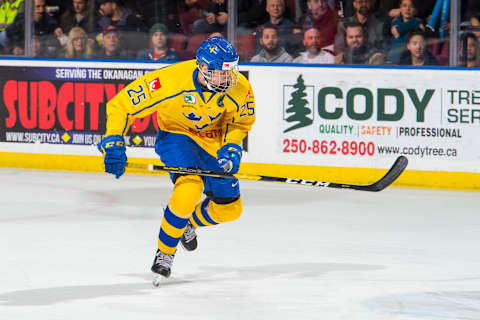
1. Philip Broberg / L / JUN 01 / AIK / Allsvenskan
Broberg is the most unique defender in this draft. In his age group, he dominated with and without the puck. He struggled to dictate as much as a rookie in a good professional league. The potential is through the roof and the basement is a top-four defender who is good in his own end, can skate, is big, and transitions the play well. If my Brent Burns gut feeling is right, the prevailing skepticism at the moment will be viewed as nitpicking in a few years.
2. Ville Heinola / L / MAR 01 / Lukko / Liiga
If popular comparisons to Miro Heiskanen are true, the position here and in my top 31 is not overzealous. Heinola is a good mix of settling smarts and aggressive pace. Precision QB in the offensive zone, even 5v5. Defensively, Heinola’s active stick and edge work allow him to pressure his opponents persistently. Entering and exiting the zone is no problem. Heinola is just south of six-foot but that’s the only concern to raise (if there is one).
Must Read. Three Under-the-Radar Free Agent Forwards to Pursue. light
3. Victor Soderstrom / R / FEB 01 / Brynas / SHL
Soderstrom’s wide stance allows him to patrol the blue line offensively or around the net defensively. Elite game processing with an above average, rounded tool set. Most of the praise will be for his offensive potential but respect how turnkey and efficient his defensive play is. Simply put, Soderstrom is the type defender I’d want to be or aim to add to my team’s core.
4. Bowen Byram / L / JUN 01 / Vancouver / WHL
Byram is basically a 4th forward, a rover on the ice. In the CHL, he can get away with that but I want to see it at a higher level before saying he is hands down the top of the class. His goal scoring touch is top end for the draft, with only Honka as close comparable.
His skating is top end for this class as well. His playoff run was absurd. But his big flaws are without the puck and in the defensive end, which is why he’s at the bottom of this tier. If the 20-goal offense doesn’t peak, he may not be a top-four defender.
Like with all my rankings, the players inside this tier are pretty interchangeable based on style preference and the team’s need. It wouldn’t surprise me to see Byram end up being the best pick of the bunch.
Tier B – Likely Top 4 Defender

5. Tobias Bjornfot / L / APR 01 / Djurgårdens / SHL
U18s was a wake-up party for scouts who slept on Bjornfot. He seems to always outplay expectations and leading PP1 for the Swedes showcased that. Defensively, Bjornfot is tough to get around, and his footwork and competitive nature shines here. Above average tools all around. Shows his smarts through good timing. A prospect I learned to stop doubting.
6. Albert Johansson / L / JAN 01 / Färjestad / SHL
An under-the-radar defender who’s as competitive and decisive as Bjornfot. Johansson isn’t as polished or NHL-ready but has more ceiling in my books. Johansson reads plays well and expertly jumps plays and passes in all three zones. His shot is average but his hands are better, especially since he hardly does too much. He started and finished the year well, despite an up and down season.
Trending. Should Montembeault Start as the Backup Next Season?. light
7. Moritz Seider / R / APR 01/ Mannheim / DEL
A player always in motion. Seider is very aggressive in the offensive zone below the hash marks but is often caught backchecking. Feels like a steal or trap pick. He’s a smart and efficient defender with an active stick and long wingspan. He makes a decent first pass but his hands betray him too often when he thinks and holds on to it. His thinking is a small concern.
I would have a development route thought out before making the pick. Seider to the AHL or Liiga, SHL? I like it a lot for picks in the ‘teens’. Cautious, but okay with the risk if he can be ‘tamed’. Especially over the USHL D or some of the next CHL guys. Some of Seider’s defensive zone play has Pronger-esque traits.
8. Thomas Harley / L / AUG 01 / Mississauga / OHL
Harley is one of the youngest top prospects in the draft. The overall picture is appealing: size, skill, athleticism, and can put up points. Although he is active all over the ice, he easily gets out of position or forgets his duties while puck chasing.
His defense is a large work in progress. Some teams will be okay with it. He fits the new possession-based rover style defender. Along with Seider, Harley has a lot to like and common sense says he makes the NHL but may be frustrating at times. Two Prospects I had trouble placing amongst Tier A/B/C.
Tier C – Top 4 Defender Upside
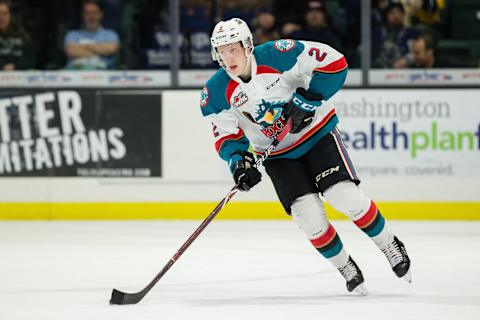
9. Lassi Thomson / R / SEP 00 / Kelowna / WHL
Hard right-shot defender with two-way potential. Good at breaking up plays and swatting pucks down, similar traits to Ekblad (with less promise but way cleaner skating). The Rockets are a defenseman factory, so the development should be pretty dependable… like Thomson. One of my favorite defenseman to watch play this year.
10. Mikko Kokkonen / L / JAN 01 / Jukurit / Liiga
Defensively, Kokkonen has few peers in this draft. He breaks up zone entries, keeps pucks in at the blue line, block shots, and is tidy getting the puck out. His offensive numbers were mainly due to playing heavy minutes on a thin Liiga team. It’s not representative of true record-setting offensive power. However, Kokkonen is a proficient puckhandler and makes a good breakout pass, it’s not crazy to think he produces enough. Kokkonen is a defender I kept up in my rankings longer than most simply because of the minutes and performance defensively at the Liiga level.
11. Iivari Rasanen / L / MAY 01 / Tappara / Jr. A
Rasanen hardly made mistakes in the games I saw. Strong first pass and first few strides. Plays with urgency and follows up the play. Gaps up on pucks and players quickly. A quick comparable to style is Kimmo Timonen (and not just because he wears #44). Hardly hear this name discussed but one of the best defenders to target earlier Day 2.
12. Anttoni Honka /R / OCT 00 / JYP / Liiga
A raw offensive defender who went through the growing pains of turning pro this season. His defensive play will never be his strong suit but he does cut off passes frequently. Honka’s offensive value lies with his creativity. He’s undersized and old for the draft but he constantly sees lanes and plays others don’t and that has more value these days. My opinion of Honka fluctuated a lot over the last year, whereas Kokkonen and Rasanen viewings were sticking positive.
13. Cam York / L / JAN 01 / USDP/ USHL
Not many have York this low. York doesn’t display much urgency or dedication to defense at a low competition level, which worries me. I also don’t see PP1 QB and 5v5 offensive contributor, Morgan Reilly style comparisons. Possible he reaches that of course but I’m leaning USDP factor. The good I do see is a defender who will win the neutral zone battles well and start transition rushes. York skates well enough to break out or enter the zone with solid success. Just not sold on first pairing dynamic style or potential.
14. Matthew Robertson / L / MAR 01 / Edmonton / WHL
An aggressive defender who still is a bit rough around the edges. Being active all over the ice brings the highs of his shifts and the lows. He has a good shot and good head on his shoulders but needs to dial it in with positioning through development.
15. Semyon Chistyakov / L / AUG 01 / Tolpar Ufa / MHL
A defender who tries to stir up momentum and kick-start the counter-attack by checking and gambling big. Chistyakov has some creativity too, and I can see an ability to finish plays. Danny Markov comes to mind. I like that he can play the off side and doesn’t over stick handle. Wish I had more viewings of him.
16. Roman Bychov / L / FEB 01 / Loko Yaroslavl / MHL
Good defensively man-on-man, and works well activating into the cycle or sticking with his man off the cycle. Offensively, Bychov is a good puck handler who can be evasive and hang onto possession. With a better shot, he could contribute some points.
17. Daniil Misyul / L / OCT 00 / Loko Yaroslavl / MHL
Raw prospect with the size, skating technique, and wingspan/stick work to be an NHL defender. Wish Misyul was as aggressive on D as he is to get up into the offense. Big gaps at times through the neutral zone show this. Good outlet pass but like some areas of his game, he needs more ummphf.
Tier D – Potential NHL Defender

18. Antti Tuomisto / R / JAN 01 / Assat / Jr. A
Eats up space and pucks. Huge hands and blade, and competitive appetite. Moves around the ice well for his size. Not Gudbranson physical but he lay hits and the lumber. Rough around the edges but if you can get the package together he could be a difference maker in one of the zones. I like him mid rounds for the long-term potential and the right shot. He’s in this tier since I don’t think he will have much versatility in the NHL.
19. Ryan Johnson / L / JUL 01 / Sioux Falls / USHL
A Minnesota commit but my knock is it is for the ’20-’21 season. His positioning is good for his level and his skating is his strength. It’s a quiet game because he mutes a lot of chances early on but he can get risky pushing up ice. The skills are there but hard to judge against competition and knowing that Johnson is staying in the USHL another year.
20. Artemi Knyaze / L / JAN 01 / Chicoutimi / QMJHL
Helped by the move to Q. Smaller ice allows his transition defense and 1-on-1 defense to shine. It also gives Knyaze more chances to get assists out of those board battle wins he is so good at. Finds tape with his passes, average puck handler. Would like to see a higher gear when needed. Getting more offensive instincts in Q also helps and should set up for a better draft + 1 year.
21. Simon Lundmark / R / OCT 00 / Linkoping / SHL
Underrated, and overlooked by myself through most of the year. Stuck behind so many defenders for national team duty and didn’t get the offensive role in SHL games. However, he has a good heavy shot, right-handed, and the calm that Swedes are known for. Ohlund-like in his posture and style. Too much side to side in his backward skating – doesn’t hold straight line defending rushes and can quickly lose a gap or get turned but is sometimes rescued by his stick.
22. Hugo Has / R / FEB 01 /Tappara / Jr. A
Has’ skating reminds me of a lanky horse’s galloping stride. Development will be key. Good defensive instincts but positioning is raw. Little too loose on O but does fulfill his role on D mostly. Possibly a little too patient on the defensive side, but the reach makes up for it. Has is a good passer when he takes his time and is aggressive on the puck but once he gets it, he can throw it away.
It’s Time to Give Olli Jokinen the Credit He Deserves. light. Must Read
23. Jordan Spence / R / FEB 01 / Moncton / QMJHL
Evolved into a minutes eater for the Wildcats as a rookie. Good vision on the breakout and transition, putting pucks into good spots. His skating is above average but he doesn’t have the quickest first step or have an extra burst side to side. When on his game, he’s a rover. PP and 4v4 he plays a set midfield position. He stares at the puck when he’s without it. That said, he closes gaps well and breaks up plays frequently with his stick.
24. Vladislav Kolyachonok / L / MAY 01 / Flint / OHL
Skates well enough, engages in the defensive zone and wants to be engaged in every play. Nice to see a defender want the puck so much but Kolyachonok holds onto it a lot with questionable decision-making. Scouts think there is more to the package than I see, and I finally started seeing some of that at the u18s, but I am definitely still lower than most on the Flint player.
25. Jackson LaCombe / L / JAN 01 / Shattuck / US-Prep
A long term project and a flier to finish out the defenders. LaCombe’s skating at the Prep school/18uAAA level guarantees him points and zone exits. His play without the puck is rough right now but he breaks up the majority of carry-ins and plays going through him. He just needs more discipline to position and role. I’ve seen enough to take him in the draft, just probably not until the final rounds and only if you aren’t hurting for picks.
Goalie Intro

I never know what to write intro-ing my goalie rankings. Goalie evaluation is notoriously hard, and the phrase “goalies are voodoo” is standard fare. So how can I possibly explain or contextualize the rankings below? Here’s my best shot.
Goalies need to be great skaters. When in the wild, outside the crease, they need to power through the extra equipment and get to pucks or back to their crease without flailing around creating chaos.
But it’s more subtle than that. Goalies need to keep their endurance in post-to-post pushes and cuts. They need to lean into their edges to get up and down quickly for rebound shots.
More from Draft
- Florida Panthers Select Forward Matthew Wedman 199th Overall
- Florida Panthers Select Forward Greg Meireles 168th Overall
- Florida Panthers Select Forward Owen Lindmark 137th Overall
- Florida Panthers Select Forward Henry Rybinski 136th Overall
- Florida Panthers Select Defenseman Carter Berger 106th Overall
No matter what style, size, or development league you prefer your tenders to be from, everyone is looking for the best skaters.
When it comes to goalie styles, I prefer any of the butterfly variations and avoid the blocking style goalies. That doesn’t mean a stand-up/blocking goalie is automatically excluded from the below list.
But the butterfly style I grew up with in the 90s, the Roy-butterfly, seems to have the right balance of technique and athleticism, and the style of goalies I give an edge to the most.
When it comes down to it, it’s all about belief in the netminder (rational or irrational). Faith is an important aspect of any practice of voodoo, like projecting goalie prospects.
Tier A – Possible NHL Goalie, Chance at Starter
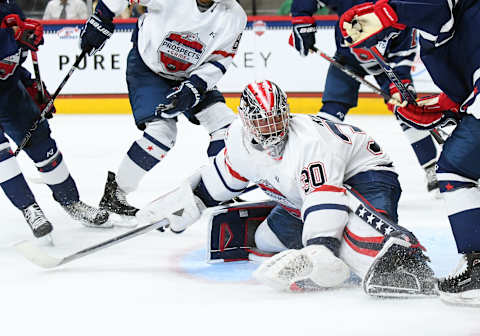
1. Spencer Knight / L / APR 01 / USDP / USHL
Big frame, big athleticism as the combine showed. Deliberate and long movements. Does a bit too much in his footwork and puck handling. Would like to see more economy and tougher competition. Good aggressiveness, good focus. Mainly high-danger chances and long periods of no shots this year made it hard to be consistent, and judge Knight’s consistency.
2. Pyotr Kochetkov / L / JUN 99 / HK Ryazan / VHL
Calm in net with fluid motions. Handles back-door plays well because of his strong base and good leg extension. I like how he controls and almost patrols his crease and how his competitive nature helped him beat goalies out for national time.
Related Story. Five Defensemen to Select with the 13th Pick. light
3. Hugo Alnefelt / L / JUN 01 / HV71 / SuperElit
Alnefelt has his doubters but he’s big, he’s athletic, he does well in his age group, and is first year eligible. It’s hard to see him not be included in the first handful of goalies selected. I usually rate HV71 goalies high (Felix Sandstrom, Adam Ahman). Alnefelt tends to overcommit short side but that’s fixable. Hopefully.
4. Ilya Konovalov / L / JUL 98 / Lokomotiv Yaroslavl / KHL
Konovalov had big numbers, big press year in the KHL. His lateral movement and no-quit allow him to steal goals and break hearts. He’s almost 21, but that’s when Bobrovsky came over to Philadelphia. See too much promise in his attacking style to pass up if I need goalie help relatively soon. Better than bidding on the open market.
5. Amir Miftakhov / L / APR 00 / Irbis Kazan / MHL
My favorite goalie in this class. Miftakhov manages the game with his rebounds and freezes the puck mindfully. Smarts and positioning are pluses, and he may be the smartest goalie in the draft. The ability to read his opponent’s intentions makes up for his shorter frame, as does a quick glove. He could see more national duty in his development.
Tier B – Possible NHL Goalie
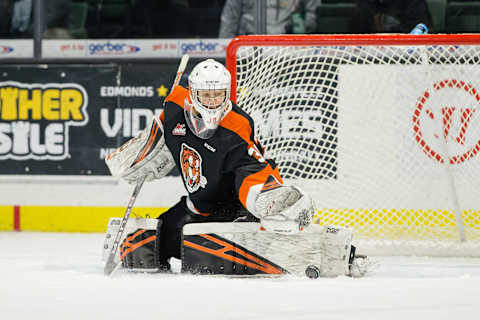
6. Lukas Parik / L / MAR 01 / Liberec / Czech U19
Baseball catcher’s mitt style glove hand. Efficient movement in the butterfly with a tall posture. Has semblances of the Luongo all-limbs butterfly style but without the absurd athleticism. Parik worries me with squeaky goals and a bigger five-hole but the potential is there. Tweaks and growth can cover that.
7. Mads Sogaard / L / DEC 00 / Medicine Hat / WHL
Mads moves well not just for his size (6’7”) but in general. He gets out to play the puck and keeps it simple. Of course with his size, he can gobble up pucks. I was higher on him to start the year but if the Russian netminders don’t do it for you, he is quickly in the top selections for goalies.
Must Read. Four Problems with the In-Game Experience. light
8. Dustin Wolf / L / APR 01 / Everett / WHL
Doing a solid job following Carter Hart. Technique over sheer talent. Plays behind a good defensive team, and a team that develops goalies well. Rebound control (blocks, doesn’t eat pucks) is a point to work on, as is his head movement when he goes down. Good angles, skating, and a good development team should help all that.
9. Taylor Gauthier / R / FEB 01 / Prince George / WHL
Catches with his right. Plays very much like a Hextall/Mike Smith goalie: a lot of sweeping pucks, swatting pucks, and kicking pucks. Does not cover puck much. Big triangle five-hole, but makes the big saves with aggressive nature and quick reflexes. A style change or learning to limit the open net could unlock a lot of potential.
10. Kari Piiroinen / L / JUL 01 / Windsor / OHL
Young for the draft class, and a goalie who struggled to adapt his angles to the OHL rink. Strong base with active stick work and tracking. Piiroinen seemed a bit behind play this year, but I’m hedging that learning curve is over. Long term, I gut-feel it comes together, and see CHL or Liiga development roads as both possible, which allows flexibility.
Tier C – Worth a Pick
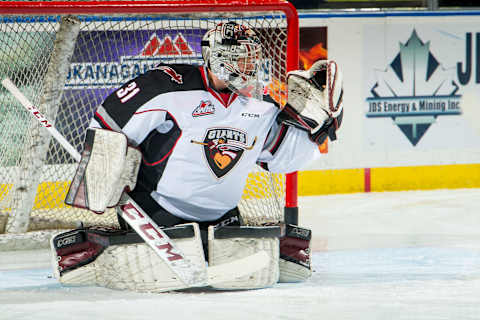
11. Trent Miner / L / FEB 01/ Vancouver / WHL
Solid progression through the ranks. Quick movements, agile — he can make the big save. Sometimes gets too wide or far from the net but recovers to his center well. Should have a good draft + 1 year. Clean up and shorten his patrol area and he could be a smart pick up.
12. Hunter Jones / L / SEP 00 / Peterborough / OHL
Pretty calm, cool, and collected. Technical but not sure I see the athletic skills to make the NHL as a starter these days. I still like the overall package and think, on the whole, Jones is better than your average mid-round CHL drafted goalie.
13. Lucas Rheyneuclaudes / L / FEB 01 / Djurgardens / SuperElit
Covers a ton of net and forces shooters to find the corners as he doesn’t let in many soft goals. Djugardens is a great team and he was behind a good prospect this year (NYR Olof Lindblom). I imagine next year he should break out. His resume is good. Why not throw a pick at him, as he should be available late in the draft.
Next. 2019 NHL Draft Prospect Forward Rankings. dark
Stay tuned for our next draft piece, as we will breakdown the top 31 skaters and provide a mock draft of the first 31 selections.